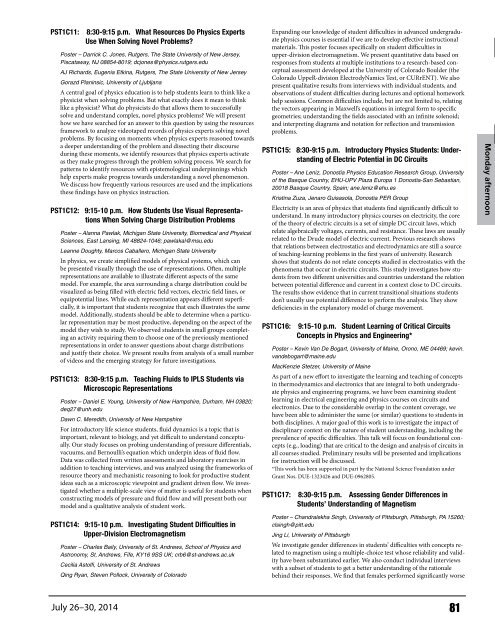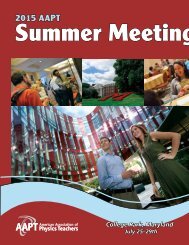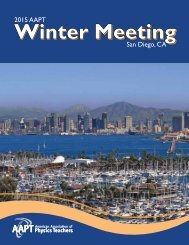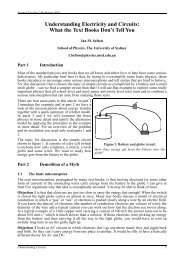Monday afternoonthat the optimal level of support for a given student population can only bedetermined by research of the type discussed here. In particular, we foundthat more scaffolding may hinder students’ performance and students maynot even discern the relevance of the added support. We provide possibleinterpretations of these findings which were developed after in-depthinterviews with some students.PST1C05:8:30-9:15 p.m. Influence of Visual Cueing on EyeMovements Using Think-Aloud ProtocolPoster – Elise Agra, Kansas State University, Department of Physics, Manhattan,KS 66506; esgagra@gmail.comXian Wu, John Hutson, Lester C. Loschky, N. Sanjay Rebello, Kansas StateUniversityResearch has shown that using visual cues to direct students’ attention torelevant areas of a diagram can facilitate problem solving. In this study, weinvestigate the effect of visual cues on students’ visual attention while theysolve conceptual physics problems with diagrams. The diagrams containedfeatures relevant to correctly solving the problem, as well as features attributedto common incorrect answers. Students enrolled in an introductorymechanics course were individually interviewed using a think-aloudprotocol. Participants worked through four problem sets while their eyemovements were recorded and they thought aloud about the problemsolution. Each set contained an initial problem, six isomorphic trainingproblems, and two transfer problems. Students in the cued condition sawvisual cues overlaid on the training problems. We discuss the influence ofboth visual cueing and feedback on students’ eye movements and thinkaloud data. This material is based upon work supported by the NationalScience Foundation under Grant Nos. 1138697 and 1348857.PST1C06: 9:15-10 p.m. Metacognition and Epistemic Games inIPLS Problem SolvingPoster – Charles J. Bertram, University of Central Arkansas, Conway, AR72035-0001; cabertram92@gmail.comAndrew Mason, University of Central ArkansasA metacognitive exercise in problem solving was given to an introductoryphysics for life sciences (IPLS) class over the course of the fall 2013 andspring 2014 semester. The exercise featured scaffolding in the form of arubric students could use to note where they struggled in a group problemsolvingeffort. One of the concerns was that students who are not physicsmajors do not necessarily have the same epistemic framework as physicsmajors would for the classroom. As such, we examine written artifactsfrom the students’ reflection activities for evidence of different epistemicgames. We also describe a comparison of written artifacts to pre-post datafrom the FCI, MPEX, and CLASS surveys.PST1C07: 8:30-9:15 p.m. Epistemic Impact on Metacognition inCooperative Group Problem SolvingPoster – Andrew J. Mason, University of Central Arkansas, Conway, AR72035-0001; ajmason@uca.eduCharles Bertram, Cassandra Lange, University of Central ArkansasCognitive apprenticeship for physics problem solving has been demonstratedto show potential for students to reflect upon their problem-solvingattempts. In the context of introductory physics for life sciences (IPLS), aconcern exists that non-physics science majors may have attitudes towardsphysics that mitigate the efficacy of a metacognitive problem-solving exercise.A weekly metacognitive intervention was administered in a lab groupproblem solving setting for a first semester algebra-based introductoryphysics course. MPEX and CLASS surveys were used in a pre-post formatfor respectively the fall 2013 and spring 2014 semesters. Other forms ofdata include written artifacts from the students themselves about aspects ofproblem solving with which they struggled, as well as an end-of-semestersurvey about the usefulness of the exercise. We discuss the effectiveness ofthe reflection task with respect to the students? attitudes towards problemsolving.PST1C08: 9:15-10 p.m. Student Srategies Solving GraphicallyBased Physics Problems Invoking the FundamentalTheorem of CalculusPoster – Rabindra R. Bajracharya. University of Maine. Orono, ME 04469;ab_study@yahoo.comJohn R. Thompson, University of MaineWe have been investigating student understanding and application of theFundamental Theorem of Calculus (FTC) in different physics contextsinvolving definite integrals. We conducted 14 semi-structured individualinterviews with introductory physics students. Our analysis, usinggrounded theory, elicited various strategies to solve graphically based FTCproblems. While many students struggled initially, at some point duringthe interviews students displayed the relevant and requisite mathematicalknowledge, suggesting that they failed to access and/or apply the knowledgein the given physics contexts. Similar to prior studies on studentsdealing with mathematically based physics problems, we found the analysisperspectives of epistemological framing and epistemic games productivein interpreting some of the choices of strategies, the strategies themselves,and some individual steps observed. The framing perspective helps explainstudents’ strategy-switching based on representations available or contextfamiliarity. We discuss our findings and relate our results to those in theliterature.PST1C09: 8:30-9:15 p.m. Eye-Gazing Behavior of StudentsSolving Graphically Based Physics ProblemsPoster – Rabindra R. Bajracharya, University of Maine, Orono, ME 04469;ab_study@yahoo.comJennifer L. Docktor, University of Wisconsin-La CrosseJohn R. Thompson, University of MaineWe report on one aspect of our multi-mode study—using written surveys,interviews, and eye tracking—of student problem-solving of graphicallybased Fundamental Theorem of Calculus problems in mathematics andphysics contexts. A free-head eye-tracking instrument recorded visualattention in the form of direction and duration of eye gaze in real time. Wefocused particularly on the proportion of time spent on various stimulusdomains—lexicons, equations & symbols, graphs, and distractors. We alsoseparately analyzed the proportion of time spent by participants on variousfeatures of the graphs. Our initial analysis of the direction and duration ofparticipants’ eye gaze indicate more time spent on equations and symbolsthan on other domains. We also found that participants who gave incorrectresponses spent more time attending to irrelevant graphical features. Wewill present a summary of these findings and compare eye-tracking resultsto responses from interviews and written surveys.PST1C10: 9:15-10 p.m. From Instructional Goals to GradingPractices: The Case of Graduate TAsPoster – Emily M. Marshman, University of Pittsburgh, 3941 O’Hara St.,Pittsburgh, PA 15260; emm101@pitt.eduAlex Maries, Chandralekha Singh, University of PittsburghEdit Yerushalmi, Weizmann InstituteCharles Henderson, Western Michigan UniversityTeaching assistants (TAs) are often responsible for grading student solutions.Grading communicates instructors’ expectations, thus TAs have acrucial role in forming students’ approaches to problem solving in physics.We investigated the grading practices and considerations of 43 first-yeargraduate students participating in a TA training course. The study utilizedfour student solutions, selected to reflect expert and novice approachesto problem solving and to elicit conflicting considerations in assigninggrades. TAs were asked to list solution features and to explain how and whythey weighed the different features to obtain a final score. We will describehow discussions of grading practices in the course, as well as one semesterof teaching experience, impacted how the TAs grade student solutions.We will relate our results to the findings of a larger study to understandinstructors’ considerations regarding the learning and teaching of problemsolving in an introductory physics course.80
PST1C11:8:30-9:15 p.m. What Resources Do Physics ExpertsUse When Solving Novel Problems?Poster – Darrick C. Jones, Rutgers, The State University of New Jersey,Piscataway, NJ 08854-8019; dcjones@physics.rutgers.eduAJ Richards, Eugenia Etkina, Rutgers, The State University of New JerseyGorazd Planinsic, University of LjubljanaA central goal of physics education is to help students learn to think like aphysicist when solving problems. But what exactly does it mean to thinklike a physicist? What do physicists do that allows them to successfullysolve and understand complex, novel physics problems? We will presenthow we have searched for an answer to this question by using the resourcesframework to analyze videotaped records of physics experts solving novelproblems. By focusing on moments when physics experts reasoned towardsa deeper understanding of the problem and dissecting their discourseduring these moments, we identify resources that physics experts activateas they make progress through the problem solving process. We search forpatterns to identify resources with epistemological underpinnings whichhelp experts make progress towards understanding a novel phenomenon.We discuss how frequently various resources are used and the implicationsthese findings have on physics instruction.PST1C12: 9:15-10 p.m. How Students Use Visual RepresentationsWhen Solving Charge Distribution ProblemsPoster – Alanna Pawlak, Michigan State University, Biomedical and PhysicalSciences, East Lansing, MI 48824-1046; pawlakal@msu.eduLeanne Doughty, Marcos Caballero, Michigan State UniversityIn physics, we create simplified models of physical systems, which canbe presented visually through the use of representations. Often, multiplerepresentations are available to illustrate different aspects of the samemodel. For example, the area surrounding a charge distribution could bevisualized as being filled with electric field vectors, electric field lines, orequipotential lines. While each representation appears different superficially,it is important that students recognize that each illustrates the samemodel. Additionally, students should be able to determine when a particularrepresentation may be most productive, depending on the aspect of themodel they wish to study. We observed students in small groups completingan activity requiring them to choose one of the previously mentionedrepresentations in order to answer questions about charge distributionsand justify their choice. We present results from analysis of a small numberof videos and the emerging strategy for future investigations.PST1C13: 8:30-9:15 p.m. Teaching Fluids to IPLS Students viaMicroscopic RepresentationsPoster – Daniel E. Young, University of New Hampshire, Durham, NH 03820;deq27@unh.eduDawn C. Meredith, University of New HampshireFor introductory life science students, fluid dynamics is a topic that isimportant, relevant to biology, and yet difficult to understand conceptually.Our study focuses on probing understanding of pressure differentials,vacuums, and Bernoulli’s equation which underpin ideas of fluid flow.Data was collected from written assessments and laboratory exercises inaddition to teaching interviews, and was analyzed using the frameworks ofresource theory and mechanistic reasoning to look for productive studentideas such as a microscopic viewpoint and gradient driven flow. We investigatedwhether a multiple-scale view of matter is useful for students whenconstructing models of pressure and fluid flow and will present both ourmodel and a qualitative analysis of student work.PST1C14: 9:15-10 p.m. Investigating Student Difficulties inUpper-Division ElectromagnetismPoster – Charles Baily, University of St. Andrews, School of Physics andAstronomy, St, Andrews, Fife, KY16 9SS UK; crb6@st-andrews.ac.ukCecilia Astolfi, University of St. AndrewsQing Ryan, Steven Pollock, University of ColoradoExpanding our knowledge of student difficulties in advanced undergraduatephysics courses is essential if we are to develop effective instructionalmaterials. This poster focuses specifically on student difficulties inupper-division electromagnetism. We present quantitative data based onresponses from students at multiple institutions to a research-based conceptualassessment developed at the University of Colorado Boulder (theColorado UppeR-division ElectrodyNamics Test, or CURrENT). We alsopresent qualitative results from interviews with individual students, andobservations of student difficulties during lectures and optional homeworkhelp sessions. Common difficulties include, but are not limited to, relatingthe vectors appearing in Maxwell’s equations in integral form to specificgeometries; understanding the fields associated with an infinite solenoid;and interpreting diagrams and notation for reflection and transmissionproblems.PST1C15: 8:30-9:15 p.m. Introductory Physics Students: Understandingof Electric Potential in DC CircuitsPoster – Ane Leniz, Donostia Physics Education Research Group, Universityof the Basque Country, EHU-UPV Plaza Europa 1 Donostia-San Sebastian,20018 Basque Country, Spain; ane.leniz@ehu.esKristina Zuza, Jenaro Guisasola, Donostia PER GroupElectricity is an area of physics that students find significantly difficult tounderstand. In many introductory physics courses on electricity, the coreof the theory of electric circuits is a set of simple DC circuit laws, whichrelate algebraically voltages, currents, and resistance. These laws are usuallyrelated to the Drude model of electric current. Previous research showsthat relations between electrostatics and electrodynamics are still a sourceof teaching-learning problems in the first years of university. Researchshows that students do not relate concepts studied in electrostatics with thephenomena that occur in electric circuits. This study investigates how studentsfrom two different universities and countries understand the relationbetween potential difference and current in a context close to DC circuits.The results show evidence that in current transitional situations studentsdon’t usually use potential difference to perform the analysis. They showdeficiencies in the explanatory model of charge movement.PST1C16: 9:15-10 p.m. Student Learning of Critical CircuitsConcepts in Physics and Engineering*Poster – Kevin Van De Bogart, University of Maine, Orono, ME 04469; kevin.vandebogart@maine.eduMacKenzie Stetzer, University of MaineAs part of a new effort to investigate the learning and teaching of conceptsin thermodynamics and electronics that are integral to both undergraduatephysics and engineering programs, we have been examining studentlearning in electrical engineering and physics courses on circuits andelectronics. Due to the considerable overlap in the content coverage, wehave been able to administer the same (or similar) questions to students inboth disciplines. A major goal of this work is to investigate the impact ofdisciplinary context on the nature of student understanding, including theprevalence of specific difficulties. This talk will focus on foundational concepts(e.g., loading) that are critical to the design and analysis of circuits inall courses studied. Preliminary results will be presented and implicationsfor instruction will be discussed.*This work has been supported in part by the National Science Foundation underGrant Nos. DUE-1323426 and DUE-0962805.PST1C17: 8:30-9:15 p.m. Assessing Gender Differences inStudents’ Understanding of MagnetismPoster – Chandralekha Singh, University of Pittsburgh, Pittsburgh, PA 15260;clsingh@pitt.eduJing Li, University of PittsburghWe investigate gender differences in students’ difficulties with concepts relatedto magnetism using a multiple-choice test whose reliability and validityhave been substantiated earlier. We also conduct individual interviewswith a subset of students to get a better understanding of the rationalebehind their responses. We find that females performed significantly worseMonday afternoonJuly 26–30, 2014 81
- Page 1:
AAPT SummerMeeting ProgramGuideMinn
- Page 5 and 6:
Welcome to MinneapolisThe 2014 Summ
- Page 7 and 8:
Session FA: Remembering John Risley
- Page 10 and 11:
Minneapolis -A city of lakes!Minnea
- Page 12 and 13:
Meeting-at-a-GlanceMeeting-at-a-Gla
- Page 14 and 15:
3-4 p.m. Melba Phillips Toast : Mee
- Page 16:
American Association ofPhysics Teac
- Page 20:
2014 Homer L. Dodge Citations for D
- Page 23 and 24:
Plenary SpeakersThe Uncanny Physics
- Page 25 and 26:
Free Commercial WorkshopsCW01: PASC
- Page 27 and 28:
AAPT Exhibitor InformationAAPT Jour
- Page 29 and 30:
TEL-Atomic, Inc.Booth #2041223 Gree
- Page 31 and 32: Session Rooms are in the STSS Build
- Page 33 and 34: Rashonda
- Page 35 and 36: W06: Inquiring into Radioactivity f
- Page 37 and 38: W20: Introductory Physics for Life
- Page 39 and 40: the generative and flexible use of
- Page 41 and 42: freely available online texts and i
- Page 45 and 46: Session SPS: SPS Undergraduate andG
- Page 47: SPS14:8-10 p.m. Electrochromic Devi
- Page 50 and 51: AA05: 9:10-9:20 a.m. Improving Seco
- Page 52 and 53: Monday morningAC02: 9:-9:30 a.m. Fr
- Page 54 and 55: Monday morninghoused in the College
- Page 56 and 57: Monday morningadd content to the te
- Page 58 and 59: Monday afternoonTOP02: Topical Disc
- Page 60 and 61: Monday afternoonproblems and later
- Page 62 and 63: Monday afternoonnovation Hyperlab p
- Page 64 and 65: Session BF: Outreach: Fun Ways toEn
- Page 66 and 67: Monday afternoonBG04:2:40-2:50 p.m.
- Page 68 and 69: Monday afternoonto make the demonst
- Page 70 and 71: Monday afternoonwith students, on-
- Page 72 and 73: Monday afternoonCD03: 5-5:10 p.m. M
- Page 74 and 75: Monday afternoonCI01:Session CH: Pa
- Page 76 and 77: Are your students tap-happy for Fla
- Page 78 and 79: Monday afternoonPST1: Poster Sessio
- Page 80 and 81: Monday afternoonindicating and reco
- Page 84 and 85: Monday afternoonthan males when the
- Page 86 and 87: Monday afternoonSaalih Allie, Unive
- Page 88 and 89: Monday afternooningful. We are a te
- Page 90 and 91: Monday afternoonPST1E06: 9:15-10 p.
- Page 92 and 93: (TAs): knowledge of introductory st
- Page 94 and 95: Tuesday morningToo often in the con
- Page 96 and 97: Tuesday morningexpose students to c
- Page 98 and 99: Tuesday morningCarolyn D. Sealfon,
- Page 100 and 101: Tuesday morningDG06:8:50-9 a.m. Exa
- Page 102 and 103: Tuesday morningSession DJ: Reform D
- Page 104 and 105: Tuesday afternoonSession EA: Panel
- Page 106 and 107: Tuesday afternoonEC03: 2-2:10 p.m.
- Page 108 and 109: We focus on the design and study of
- Page 110 and 111: EF04:2:10-2:20 p.m. Integration in
- Page 112 and 113: Session EJ: TechnologiesLocation: S
- Page 114 and 115: PST2: Poster Session 2Location: Cof
- Page 116 and 117: Tuesday afternoonPoster - Marcos D.
- Page 118 and 119: Tuesday afternoonevaluate the succe
- Page 120 and 121: Tuesday afternoonIn Fall 2013, Geor
- Page 122 and 123: Tuesday afternoonPST2C32: 5:45-6:30
- Page 124 and 125: Tuesday afternoonthe direction of e
- Page 126 and 127: Electrostatics Diagnostic (CUE), pr
- Page 128 and 129: Wednesday morningFA03:8:30-10:30 a.
- Page 130 and 131: FD03:8:50-9 a.m. Integrating Practi
- Page 132 and 133:
while they learn physics from two c
- Page 134 and 135:
homework, forum, at-home labs) and
- Page 136 and 137:
FK05:10-10:10 a.m. Women’s Ways o
- Page 138 and 139:
GA06:1:50-2 p.m. Do Individual Thin
- Page 140 and 141:
Bohr proposed that the electron orb
- Page 142 and 143:
Wednesday afternoon140(HPC) and CUD
- Page 144 and 145:
Wednesday afternoonof RBIS is not u
- Page 146 and 147:
Wednesday afternoon0. Sample cards
- Page 148 and 149:
Wednesday morningand fabrication. T
- Page 150 and 151:
Wednesday afternoonPST2G03: 1-1:45
- Page 152 and 153:
Wednesday afternoon150present preli
- Page 154 and 155:
Index of ParticipantsAbel, Yolanda,
- Page 156 and 157:
PST2C35Lincoln, James J., EE04, PST
- Page 158 and 159:
Campus MapU.M.156Portland
- Page 160 and 161:
Coffman Union - Dining-ChickFilA: 1
- Page 162 and 163:
#160
- Page 164:
San DiegoWe’ll see youin San Dieg
- Page 167 and 168:
NOTESJuly 26-30, 2014 165
- Page 169 and 170:
EDUCATIONwww.modusmed.comAn effecti






